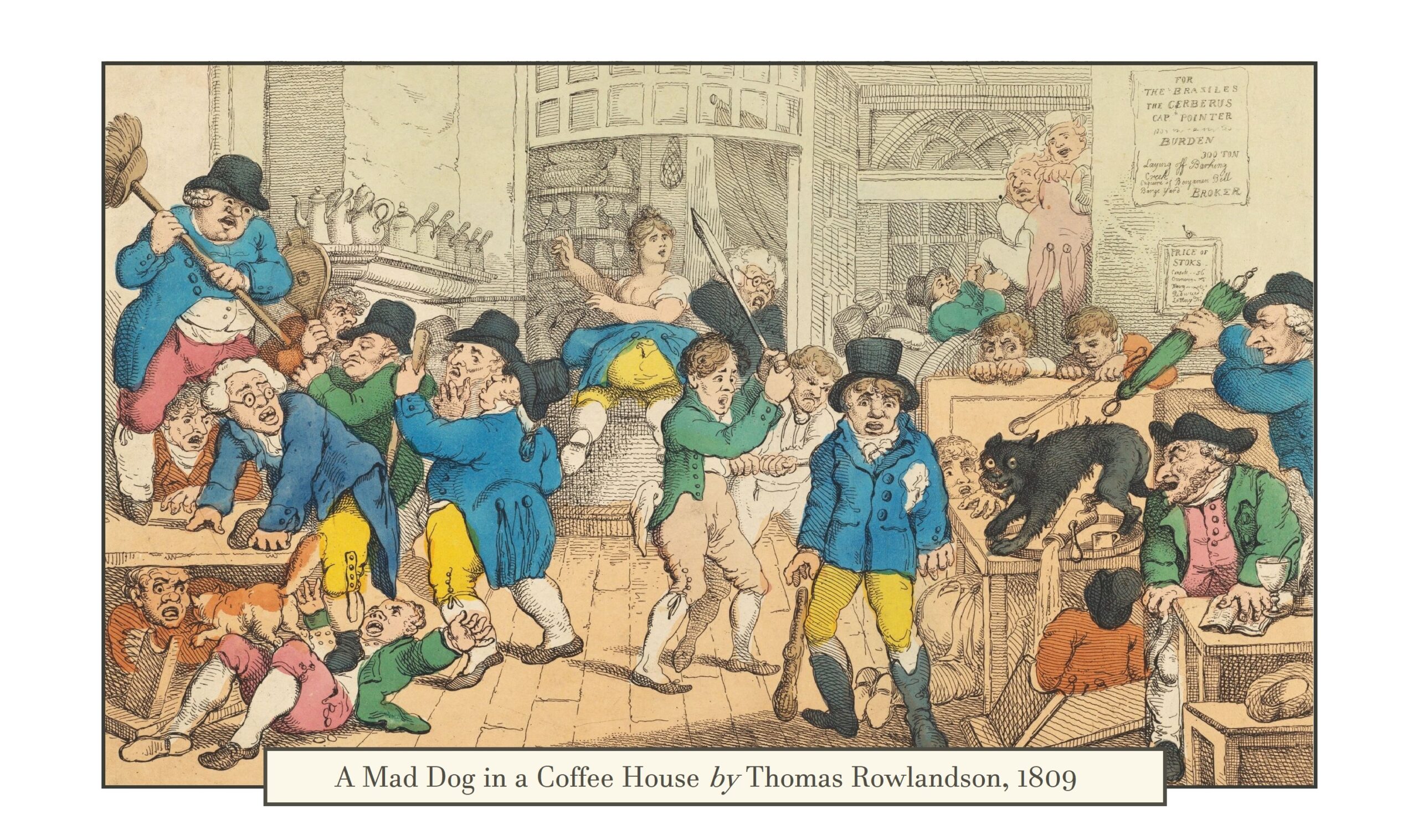
Well, perhaps not exactly ‘great’. Skimming through some old newspaper articles, I came across a minor criminal case that is so completely of its time I think it deserves a post all to itself. So, to prove that the past truly is a foreign country, I present to you the crimes, punishment and redemption of George Gatehouse, alias John Simpson, thief.
Simpson’s arrest on 18 August 1803 was through plain bad luck, despite a reward of £20 for information leading to his arrest having already been offered by the Society for Prosecuting Swindlers. He had entered the Guildhall Coffee-house, King Street, in the heart of the Square Mile that evening, with the appearance of a stylish young gentleman of good breeding. He ordered supper and a bed.
Just as he did so, a waiter from the nearby City Coffee-house on Cheapside, calling on business, recognised Simpson as the man who had robbed ‘a young foreigner’ of goods worth almost £17 (£1,800 today) while staying at the City just two months earlier. Committing theft there would seem a foolhardy move, as the proprietor was known as ‘Mad Stone’ – it is surely unwise ever to cross a man with the word ‘Mad’ in his name. However, Simpson had escaped before his crime was discovered. With the waiter’s news, Thomas Feather, the Guildhall proprietor, looked at his new guest more closely, and began to suspect he was looking at the man who had robbed one of his own visitors of linen and other articles valued at £16 in May. Theft of goods worth 40 shillings or more was a capital offence, and Simpson’s life was suddenly in grave peril.
After he had retired to bed, a constable was sent for. The suspect was woken and, appearing agitated, was handcuffed as he was searched. There was found a set of skeleton keys and ‘a curious instrument for opening trunks, drawers etc., so constructed as, by a gentle pressure of the hand, to yield a purchase equal to 200 weight.’ A further search revealed a gold pocket watch and two £1 notes. Simpson was arrested by the appropriately-named constable, Mr. Coffee, and forced to take the short walk to the Poultry Compter. This was a small gaol in a state of terminal dereliction close to Mansion House, on a street used in centuries past as a chicken market.
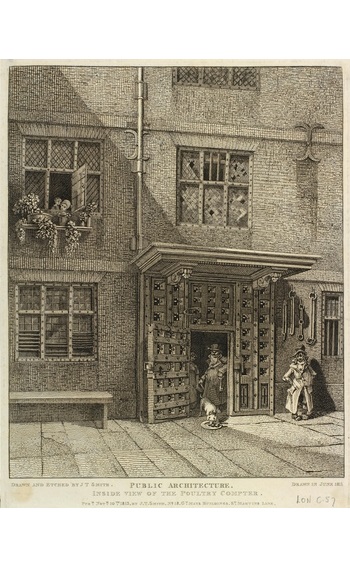
← The interior courtyard of the Poultry Compter (1807).
It was run by a City Sheriff, and typically used for imprisoning those guilty of civil offences in the Square Mile, mainly debt, although shortly before it saw John Simpson, the Compter had seen rather too much of another man, who had been arrested in his birthday suit near Mansion House on a Friday night, after accepting a wager of 10 guineas – about £1,000 today – to run naked from Cornhill to Cheapside. By this time the Compter was approaching the end of its centuries-long existence. An 1803 official report claimed that it was ‘in such a state of decay, as to become inadequate to the safe custody of the debtors and prisoners therein confined, and extremely dangerous.’ In this respect the Compter could be seen as a metaphor for the entire criminal justice system through which Simpson would pass. It was closed and demolished soon after.
Officials suspected that the ‘shag breeches’ – that is, breeches made of inferior silk – Simpson was wearing were ones stolen from the City Coffee-house. Noticing this, Simpson had the affront to secretly change them for ‘nankeen pantaloons’ – fashionable pale-yellowish cotton, figure-hugging leggings made of material produced in Nanjing, China – but the breeches were quickly discovered, hidden elsewhere in the gaol, by constable Tippey after a tip-off (I’m not making this up). Concealed within them was an eye-glass.
News of Simpson’s arrest was spreading, and more coffee-house proprietors were coming forward with tales of theft that they tried to pin on him. Most ominously for our pantaloon aficionado was the owner of the New Hummums Coffee-house in Covent Garden just outside the City, an establishment attached to a rather dubious and disreputable bathhouse. This owner, Mr. Joy, identified Simpson from earlier in the month, as a visitor who sought a bed after claiming he had been attending a gala event at Vauxhall Gardens. This visitor had then proceeded during the night to steal a gold pocket watch, gilt eye-glass and two £1 banknotes from a fellow guest, Thomas Glover, a City underwriter. The make and number of the watch exactly matched those of the one Simpson had in his possession. Glover also believed the eye-glass to be his.
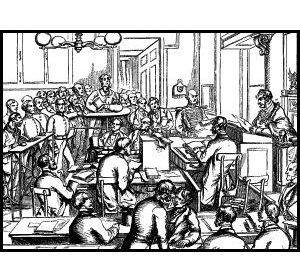
Simpson was questioned on 19 August before the Lord Mayor of London, Sir Charles Price. The Lord Mayor was, and remains, the chief magistrate of the City, although in modern times he or she symbolically adjourns an occasional session at the Old Bailey. In days of yore they actively presided over cases, and hearings would frequently – as in this case – be held in the justice room within Mansion House, his official home. Representatives of the three coffee-houses were present. The Bury and Norwich Post reported that Simpson ‘was dressed in the most flashy style’ (their emphasis), while the Morning Post described him as a ‘gay, fashionably dressed young man‘.
← A hearing at the justice room of Mansion House, early nineteenth century
Simpson claimed to be an officer – of HMS Victory, no less – and a gentleman. There is no evidence that either was true, but he stuck to his story at each subsequent hearing. He also admitted that he was not called Simpson, but wouldn’t reveal his real name because, he said, his predicament would kill his elderly parents.
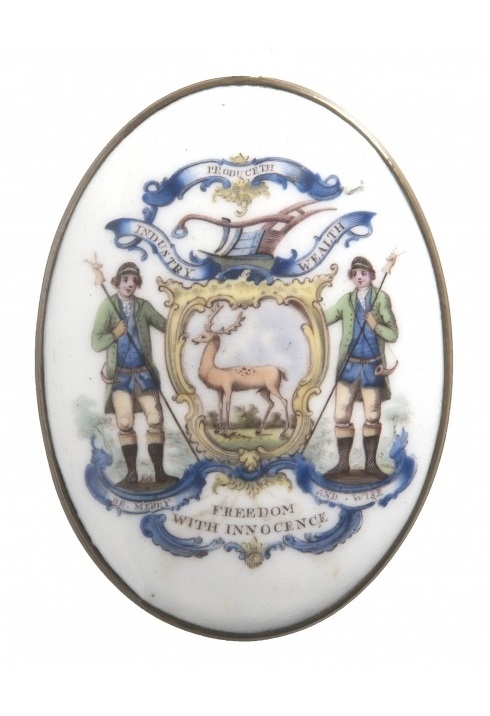
He was examined a second time at Mansion House on 23 August, this time with additional accusations being made. Mr. Bruce, of the Crown Tavern on Aldgate, swore the prisoner had absconded with sheets and new bed hangings on 29 May. Mr. Mackenzie, of the Globe Coffee-house, Fleet Street, took the accusations to another level. He claimed Simpson had stolen around £280 in cash – a suspiciously large sum, around £30,000 today – from a guest. Admittedly, the Globe was much frequented by lawyers, who are not renowned for their poverty, so the accusation was at least plausible. In each case, the proprietor claimed they had felt obliged to make good the guest’s loss – none of this ‘leave valuables in your room at your own risk’. Simpson was committed for trial, with the various accusing parties bound over to prosecute.
Newspapers were now reporting that Simpson was a member of the Most Ancient and Honourable Society of Bucks, an obscure, exclusive and somewhat eccentric fraternity that somehow claimed direct lineage from the mythical Mesopotamian king Nimrod. It had a wealthy membership noted for rowdy and drunken behaviour. This could only add to Simpson’s charisma.
← An enamel badge showing the coat of arms of the Most Ancient and Honourable Society of Bucks. The reference to innocence is presumably tongue-in-cheek.
The trial was scheduled for 14 September at the Sessions House of Newgate Prison, known even 200 years ago as the Old Bailey after the street on which it stood. The prosecution of Simpson was funded by the United Body of Tavern and Coffee-house Keepers, one of many organisations that pursued prosecutions in the days before a formal police force or public prosecution service.
→ An illustration of a trial at the Old Bailey Sessions House in 1808.
At the trial, Simpson’s real name was stated to be George Gatehouse, which was true, and his place of birth Devon, which wasn’t – he was born in Dorset in 1778. Only charges related to the New Hummums were heard, but the high value of the watch stolen from Mr. Glover there meant his life was still on the line. The jury seemed reluctant to find him guilty of a capital crime; the Common Sergeant, in charge of the court, suggested that as there was no confirmed valuation of the watch and eyeglass, their total worth might be considered only 39 shillings – something palpably absurd. The jury, relieved, immediately found him guilty, and he was sentenced to transportation to Australia for 7 years. But what if the jury had not been offered the 39 shilling escape route? They may have found Gatehouse not guilty to avoid having blood on their hands; such a verdict, flying in the face of the evidence, was not uncommon.
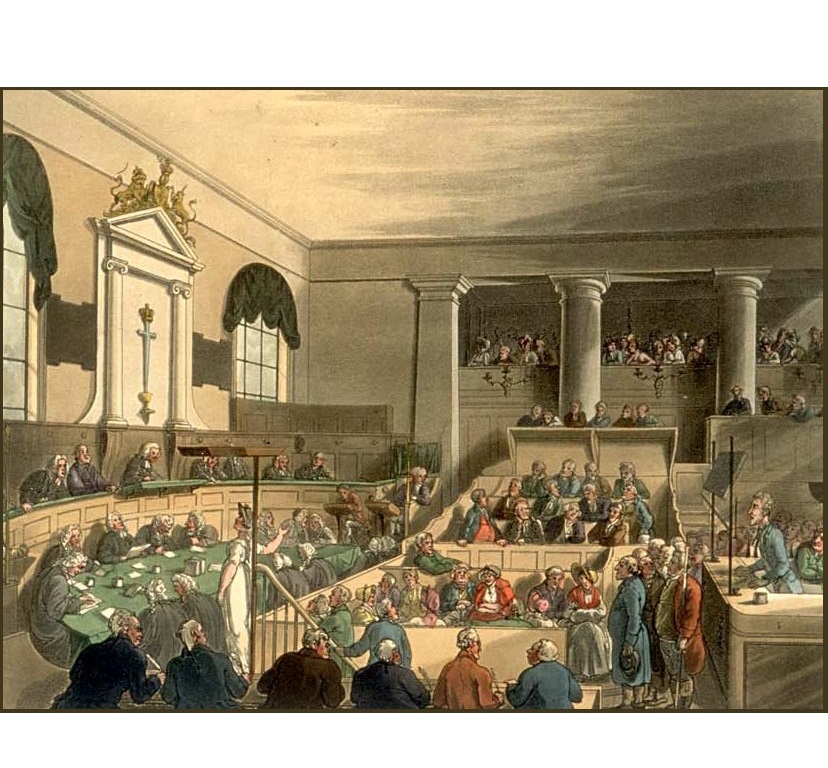
Reports after the trial suggested he was a regular offender, eluding capture and continuing his one-man crime wave for so long by being a charming master of disguise. As you have probably already deduced, his modus operandi was to take a room at a coffee-house, tavern or hotel in or near the City of London, appearing as a respectable and wealthy young man. He would request supper, pay for both room and meal so as not to arouse suspicion, then rob other guests and the proprietor during the night by silently breaking into their rooms.
The Daily Advertiser, in summing up the case, went back to fashion. It described Gatehouse as ‘in both dress and manners, completely a Bond-Street lounger’. The ‘Wicked William’ Regency blog notes that by the 1790s it was considered cool by certain young men to be described thus, for it signified a person of high fashion, whose sole purpose was to display exquisite taste by parading ostentatiously in Bond Street. However, the pointed reference to manners suggests a rather back-handed compliment by the newspaper, as loungers were renowned for lacking them.
→ High-Change in Bond Street (1796). James Gillray illustrates the lack of manners of the Bond Street loungers, as they take up the whole footpath, forcing ladies to walk in the filthy street.
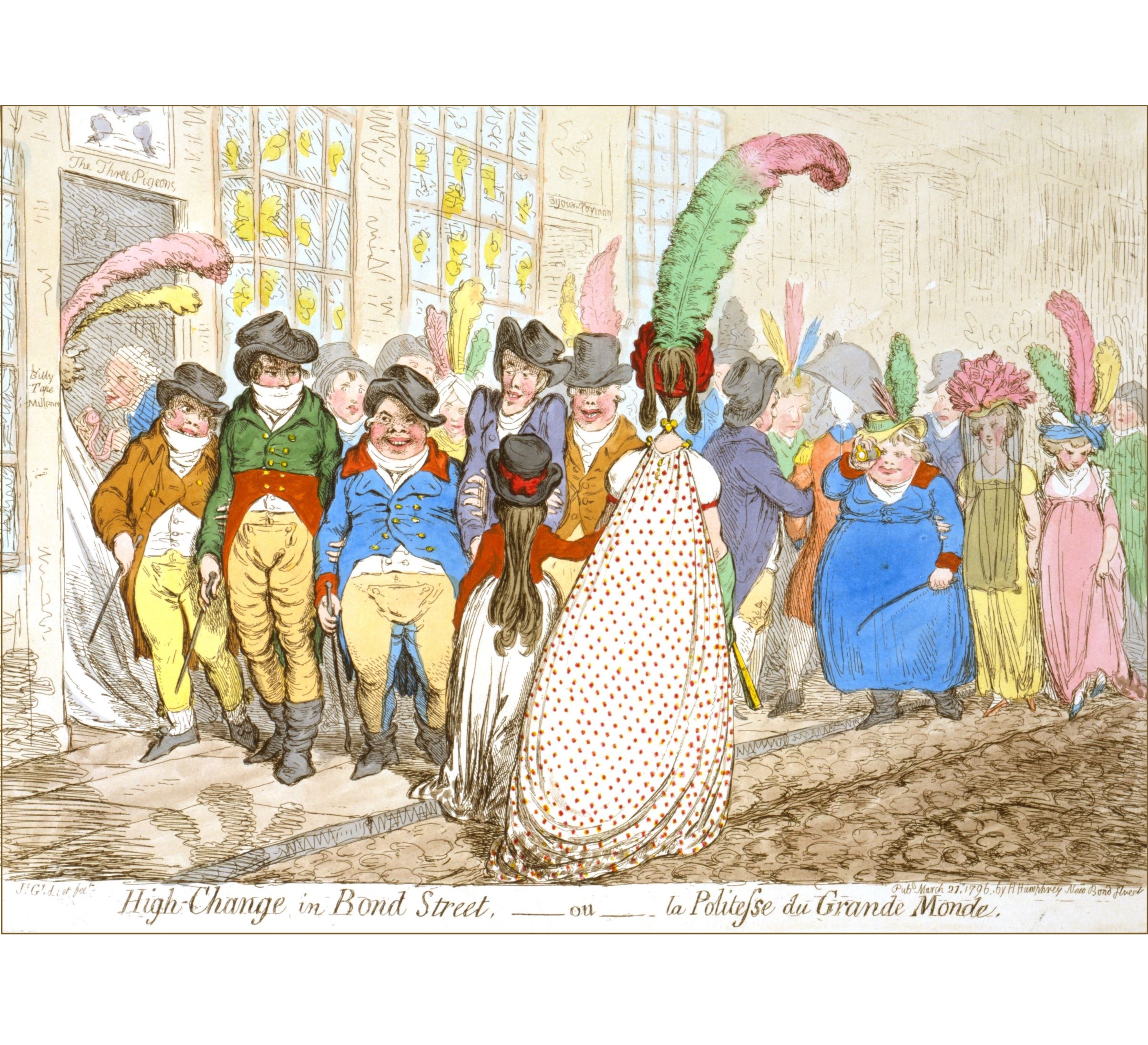
After sentencing, Gatehouse was transferred from Newgate Prison to a hulk on the Thames at Woolwich – an old Spanish vessel appropriately renamed the Retribution. Here he waited to be transported to Australia. The flashy, fashionably-dressed Bond Street lounger was in for a rude shock: Conditions on board the hulk were appalling, disease rife. Prisoners were locked in irons overnight, the food was rotten, and we have the words of another prisoner on the same hulk at about the same time, also awaiting transportation, describing their day:
Every morning, at seven o’clock, all the convicts capable of … getting into the boats, are taken ashore to the Warren, in which the Royal Arsenal and other public buildings are situated, and there employed at various kinds of labour; some of them very fatiguing; and while so employed, each gang … is watched and directed by a … guard. These guards are commonly of the lowest class of human beings; wretches devoid of feeling; ignorant in the extreme, brutal by nature, and rendered tyrannical and cruel by the consciousness of the power they possess.
James Hardy Vaux
Gatehouse was eventually transferred to the vessel Coromandel with 199 other convicts, and it sailed on 4 December, arriving in Port Jackson (Sydney), New South Wales on 5 May 1804. He survived his seven years, and his style and charisma did not desert him. He returned to England in 1812, married Edith Best at St Marylebone, London and through means unidentified raised a large sum of money with which he returned to Australia in 1816; he obtained several grants and bought land at New Town – the oldest part of Hobart, Tasmania – where he established an orchard and, in 1820, the New Town Brewery. His investments prospered; as well as brewer, he was a banker, fruit grower, general merchant and tobacco farmer. Government officials spoke highly of his probity and character. He died childless, but a very wealthy man, in 1838, having brought out from England several relatives to share in that wealth. To this day, Gatehouses own land in the area. He even has an entry in the Australian Dictionary of National Biography. Not bad for a man who would, but for a shilling, have been hanged in 1803.
Traditional coffee houses, Vauxhall Pleasure Gardens, shag breeches and nankeen pantaloons, Bond Street loungers and the Society of Bucks, the Lord Mayor presiding over court cases at Mansion House, independent societies pressing criminal charges, City Compters, prison hulks, transportation, execution for theft of 40 shillings … Gatehouse’s London is unrecognisable to us, and that’s probably no bad thing. Having said that, there are still dubious establishments in Covent Garden – I’ve eaten in one recently, and I can tell you my eggs benedict were very dubious indeed. Theft, of course, will always be with us. As will drunken men running naked through the streets of a Friday night for a bet.
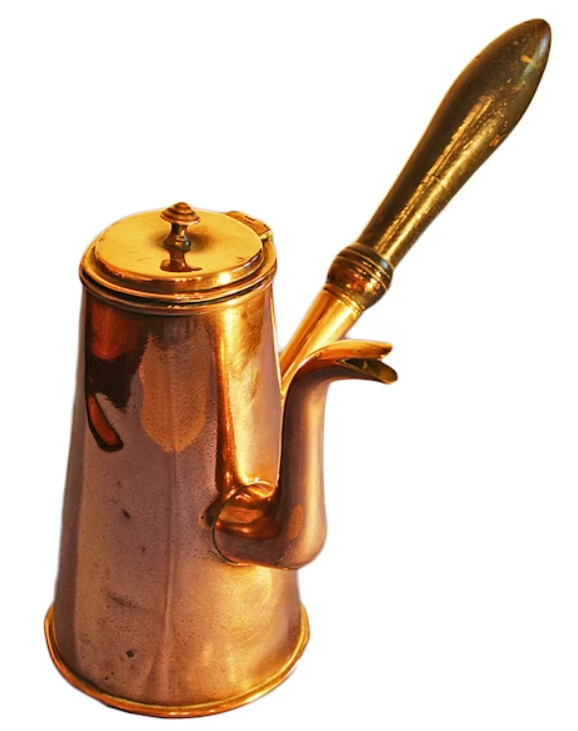
Nearest Stations: Of the buildings mentioned standing at the time, only the Mansion House survives in its original form although it no longer contains a court.
Credits:
Selected Bibliography: